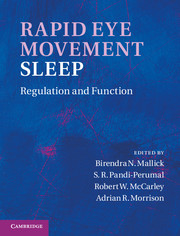Book contents
- Frontmatter
- Contents
- Contributors
- Preface
- Acknowledgments
- Organization
- Section I Historical context
- Section II General biology
- Section III Neuronal regulation
- Section IV Neuroanatomy and neurochemistry
- Section V Functional significance
- Section VI Disturbance in the REM sleep-generating mechanism
- 40 Narcolepsy and REM sleep
- 41 REM sleep and dreams: relationship to anxiety, psychosomatic, and behavioral disorders
- 42 REM sleep and emotion regulation
- 43 Neural modeling for cooperative/competitive regulation of REM sleep with NREM sleep and wakefulness
- 44 The selective mood-regulatory theory of dreaming: an adaptive, assimilative, and experimentally based theory of dreaming
- Index
- Plate section
- References
43 - Neural modeling for cooperative/competitive regulation of REM sleep with NREM sleep and wakefulness
from Section VI - Disturbance in the REM sleep-generating mechanism
Published online by Cambridge University Press: 07 September 2011
- Frontmatter
- Contents
- Contributors
- Preface
- Acknowledgments
- Organization
- Section I Historical context
- Section II General biology
- Section III Neuronal regulation
- Section IV Neuroanatomy and neurochemistry
- Section V Functional significance
- Section VI Disturbance in the REM sleep-generating mechanism
- 40 Narcolepsy and REM sleep
- 41 REM sleep and dreams: relationship to anxiety, psychosomatic, and behavioral disorders
- 42 REM sleep and emotion regulation
- 43 Neural modeling for cooperative/competitive regulation of REM sleep with NREM sleep and wakefulness
- 44 The selective mood-regulatory theory of dreaming: an adaptive, assimilative, and experimentally based theory of dreaming
- Index
- Plate section
- References
Summary
Summary
Recently, we proposed the model consists of a quartet of neuron groups: (1) sleep-active preoptic/anterior hypothalamic neurons (N-R group); (2) wake-active hypothalamic and brain-stem neurons exhibiting the highest rate of discharge during wakefulness and the lowest rate of discharge during paradoxical or REM sleep (WA group); (3) brain-stem neurons exhibiting the highest rate of discharge during REM sleep (REM group); and (4) basal forebrain, hypothalamic, and brain-stem neurons exhibiting a higher rate of discharge during both wakefulness and REM sleep than during NREM sleep (W-R group). In this chapter, we explain our revised model of sleep–wakefulness regulation in the rat, which includes a neural regulator quartet of NREM sleep, REM sleep, wakefulness, and a coregulator of REM sleep and wakefulness, whose parameters are tuned up so that the model reproduces some of the recent findings concerning the WA neurons. The physiological reality of the model structure is demonstrated by comparing the model neuron activities with the actual neuronal activities across state transition. Among the conceptual and mathematical models, one of the novel features of our model is involvement of the cholinergic W-R neuron group, which is assumed to contribute toward induction of wakefulness as well as REM sleep by selectively mediating autocatalytic activation with the WA or REM neurons. Through activity of this neuron group, the wakefulness–sleep flip-flop and the REM–NREM flip-flop interact with each other in our model. In fact pharmacological or physiological manipulations of REM sleep were shown to affect not only NREM sleep but wakefulness. Our successful modeling suggests that REM sleep is regulated cooperatively/competitively with NREM sleep and wakefulness by well orchestrated interactions among the aforementioned quartet of neural groups distributed in the hypothalamus and the brain stem with the aid of sleep-promoting substances. Finally, further possible updates in the model structure are described considering recent physiological findings.
- Type
- Chapter
- Information
- Rapid Eye Movement SleepRegulation and Function, pp. 437 - 449Publisher: Cambridge University PressPrint publication year: 2011
References
- 1
- Cited by



